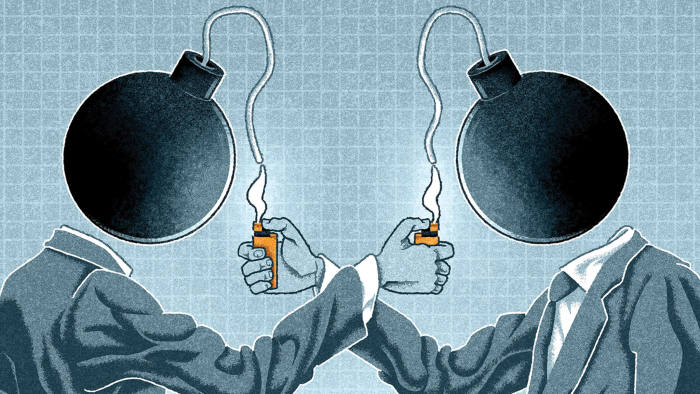Hiroshima, August 6th, 1945. The day the USA drew a line in the sand, a clear divide between the old and new, welcoming in a new era of military power with a bang.
For the Japanese, it was a day of shock, mourning and catastrophe. For the Allies, one step closer to victory. For the rest of the world, the light at the end of the tunnel was finally visible and the slow trudge that the planet had endured for nearly six years was coming to a close. World War II war coming to an end.
Three long days later, at the request of the newly inaugurated President Truman acting on the recommendations of his senior advisers, the Enola Gay US military aircraft dropped a second atomic bomb, this time on the city of Nagasaki. With the deployment of such a weapon, the world could never go back – the capacity for destruction had changed forever.
History tells us that two great superpowers emerged from the rubble of the Second World War. Each represented one half of a world divided. The USA at the forefront of the Western World’s neoliberal campaign, and the USSR looking to equal their might and establish superiority in the East under a communist regime. These governments knew that the country who held the balance of power would be able to call the shots, and with both sides fuelled by a hunger for global dominance, and a creation of a new world order in their own vision, it seemed to everyone that it was only a matter of time before chaos erupted. And they were right.
On the 29th of August 1949, something happened causing the planet to take a large collective breath.
Only four years after the USA unveiled their secrets to the rest of the world, scientists and military commanders acting under the command of Joseph Stalin dropped both a literal and metaphoric bombshell. The USSR had just tested their own nuclear weapon, and to make matters worse for the West, the test proved to be very successful. With both sides now in possession of nuclear arsenals, a third major global conflict in under half a century appeared more and more likely with each passing day.
As tensions increased, both sides became unwilling to be the first to fire the shots. Knowing unprompted strikes would not result in any approval from other powers, proxy wars were fought, won and lost, flexing military might without the use of nuclear weapons.
And thus, Mutually Assured Destruction, colloquialised as MAD, was born.

Matt Kenyon / Financial Times
MAD. The term coined ironically by JFK’s Secretary of Defence, Robert McNamara, to argue that the stockpiling of atomic weapons with the capacity to destroy all of the planet, and therefore, the people who lived on it, was rather irrational, (to say the least), morphed into something that governments of the past and present have used as a seatbelt, taken for granted but easily unclipped. A reminder of the power that certain individuals have access to at their fingertips, and the potential irreversible damage they could cause if given the right chance, or reason.
Despite their involvement in a whirlwind of battles and conflicts – either directly or through support for rebel groups – the USA and USSR never fired directly upon each other, let alone engaging in conflict with nuclear weapons. Instead, like cruel puppet masters, they toyed with the lives of others, sometimes outspoken in their support. At other times, silently hiding in the shadows sending supplies under the table while whispering in the ears of their puppets promises of stability and strength.
When the Berlin Wall was torn down brick by brick, and the USSR was finally dissolved, many thought that the stress of the nuclear threat was over. Regrettably, they were wrong.
People say that history repeats itself if lessons are not learnt from the past, and while it could be concluded that the governments of yesteryear did indeed recognise the terrifying nature of their words and actions, this conclusion fails to account for a large part of the equation. 2022 presents a new wave of power-hungry individuals with a large dash of patriotism and a score to settle. Even though the theory the idea of MAD may be true, it may be argued that while our world’s leaders do understand the potential consequences of their actions, some of them may be willing to ignore this destruction for the sake of furthering their agendas.
Over three decades later, it seems that we are once again watching powerful governments readying themselves for war. Issues in wider Ukraine have been brewing for years now, culminating in a hostile Russian takeover of Crimea and Sevastopol in 2014. In the present day, the recent invasion of Ukraine by Russia has taken many aback, yet how far is Putin and the wider Russian Federation willing to go? The answer remains to be seen.
Playing politics with people’s lives should never be an option. For nearly 75 years MAD has been viewed as a barrier, a safety net for the earth and its inhabitants. An invisible line that under no circumstances should be crossed, regardless of the situation. But this promise to the global population securing an end to world-wide conflict appears to be on the verge of being broken with the outbreaks of various global conflicts. The question – are any states ready to commit and challenge the longstanding belief surrounding the destructive nature of nuclear warfare?
Bibliography:
- https://www.bbc.com/news/magazine-17026538
- https://www.nationalww2museum.org/war/articles/bombing-nagasaki-august-9-1945
- https://www.nationalww2museum.org/war/articles/atomic-bomb-hiroshima
- https://www.pewresearch.org/fact-tank/2015/08/04/70-years-after-hiroshima-opinions-have-shifted-on-use-of-atomic-bomb/#:~:text=At%20the%20same%20time%2C%20only,34%25%20saying%20it%20was%20not.
- https://foreignpolicy.com/2009/11/09/the-dustbin-of-history-mutual-assured-destruction/
- https://warontherocks.com/2021/06/revolutionary-thinking-questioning-the-conventional-wisdom-on-nuclear-deterrence/


